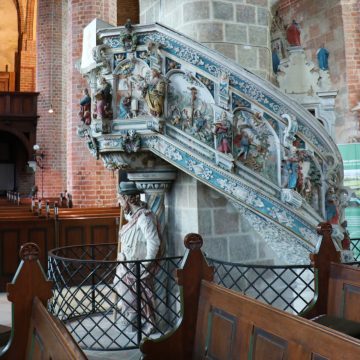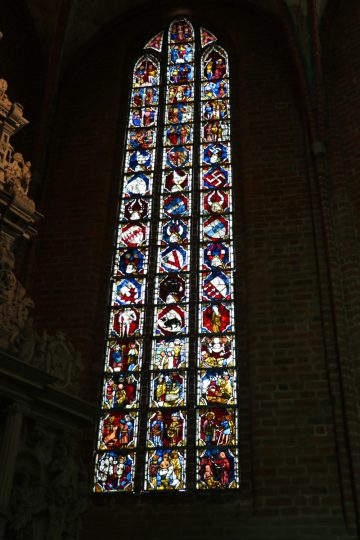The St. Jacobikirche (St James) in Stendal is a brick Gothic hall church with magnificent medieval art and the oldest stained-glass windows in Northern Germany.

Stendal is the largest town in the Altmark region of northern Saxony-Anhalt in Germany. It was relatively rich during the late Middle Ages and benefited from being a garrison town with excellent transportation links since the 17th century. It has several Gothic sights with the somewhat unassuming St Jacobikirche home to a surprisingly impressive collection of medieval art and the oldest stained-glass windows in northern Germany.
St. Jacobikirche in Stendal
On a hike to the center from Stendal’s über impressive brick Gothic Uenglinger Tor town gate tower, visitors pass by the relatively small St. Jacobikirche. Its single tower is a 19th-century replacement for the original Romanesque tower that collapsed in 1805 and although the twin towers of the Marienkirche already beckon further down Breite Straße, it is absolutely worth peaking into this church for some magnificent medieval art and impressive stained-glass windows.
The St. Jacobikirche (St James’ Church) is probably the oldest of Stendal’s historic churches. The four square pillars mark the corners of the original Romanesque church that was replaced from 1311 by a much larger triple-nave brick Gothic hall church with a choir. Work was completed shortly before 1500.
The lower walls are of stone but the upper sections are like most churches in the region in brick. The Gothic vaulting is as always impressive but the main reason to visit this church is not the architecture or history but rather the art.
High Gothic Rood Screen

The first obvious large artwork in the Jacobikirche in Stendal is the colorful High Gothic rood screen (Chorschranke). It combined metalwork with wood-carved statues and panels.
Below Christ on the Cross are sculptures of Mary and John. The central scene is the Coronation of Mary surrounded by the twelve apostles. Peter with keys is second from the left — uncharacteristically far from the center for such group portrayals.
The screen is from around 1500 and thus one of the last made in the region. The Reformation was introduced in Stendal in 1539 making such screens separating the choir with High Altar from the rest of the church irrelevant.
It is remarkable that the screen survived at all. Many a Marienkirche in Germany kept the name but lost its Mary statues after the Reformation — the coronation and assumption of Mary are non-Biblical events and thorns in the flesh of many Protestants. See for example the exquisite Marienaltar in the Herrgottskirche in Creglingen by Tilman Riemenschneider that only survived by being kept closed for centuries.
Chancel and High Altar by Hans Haake

The chancel and high altar are by Hans Haake — like Riemenschneider he worked in both wood and stone. Both works are highlights of the Renaissance in central Germany by this local artist of whom little is known today.
The chancel (completed in 1612, restored in 1902) is decorated with a variety of Biblical scenes. It is carried on the shoulders of St James, who has his typical staff, scallop shell, and hat while the face is modeled on that of Daniel Mah, a fiery local preacher whose epitaph is on the opposite wall. The soundboard was produced in 1902 using older statues.
The high altar (1602) is also by Haake who used exceptionally deeply carved reliefs in this monument work.
The sandstone was originally painted. The central scene is the Passover meal eaten in haste by Moses and the Elders of Israel before leaving Egypt — loins girded, shoes on the feet, and staff in hand. The lower scene is the Last Supper of Christ with the twelve disciples.
Higher up is Christ the Savior and the Holy Trinity. On the wings are sculptures of Hieronymus and James. Above these saints, only the two figures in the small cartouches spoil the very catholic appearance of this protestant altar — they are Martin Luther and Justus Jonas, who introduced the reformation to Stendal.
Choir Benches in Jacobikirche in Stendal

The oak choir benches are from 1420 and the high Gothic choir was thus designed around them to ensure this perfect fit. The carved figures on the backrests are mostly saint and biblical figures.
The misericords (mercy seats) have typical interesting carvings. In contrast to many other churches, visitors are welcome to lift them up to have a closer look but are requested to lower the seat (“Klappe”) with care not to make noise. This explains the origin of the German expression “die Klappe zu halten”, i.e., keep your trap (shut).
Stain-Glassed Windows
Finally the stained-glass windows in the choir! These date partly from the 14th century and are thus the oldest in northern Germany. Originally, all the church windows were as colorful but these are the only survivors and are not necessarily in their original position. Most of the damage was done during the Thirty Years War (1618-48) and the Napoleonic Wars of the early 19th century.
The scenes are from Biblical events (the Passion of Christ behind the high altar is probably the easiest to read), saints, and medieval crafts. One window now has many shields of Altmark noble families. These shields were only grouped together during the 19th century. Originally, each would have been with the scenes the family had sponsored. The two Swastika shields are 15th-century originals — installed five centuries before these symbols got a totally different meaning in Germany.
The Jacobikirche was altered and restored through the centuries so it is often hard to impossible to date some of the other art, frescoes, and detail paintings. The epitaphs and gravestones were mostly brought into the church from the surrounding graveyard in the 19th century.
The organ box, bell tower, and three bells are from the big restoration project around 1900. The youngest artwork in the church is the wooden angel carved by local artist Dieter Schröder in 2002.
St Jacobikirche Visitors Information
The St Jacobikirche, Jacobikirchhof 1, 39576 Stendal, is open weekdays from May to September from 10:00 to 12:00 and 13:00 to 15:00. It is usually closed from October to April. The church might be open on weekends during vacation periods.
The St Jacobikirche is a few blocks along Breite Straße to the north of the Marienkirche and Rathaus. From the church, it is a short walk to the very impressive brick Gothic Uenglinger Tor town gate tower. En route, in Altes Dorf note the war memorials that were partly destroyed during the German Democratic Republic era, as a protest against the glorification of war. Also, peak through the fence of the Winckelmannmuseum to see the largest wooden Trojan horse in the world.
The most impressive stained-glass windows in Stendal are in the Dom St Nikolaus, which is not actually a cathedral but the glass is absolutely not fake — well worth the trek to the southern part of the old town.
More on Hansestadt Stendal
- Brick Gothic Town Gate Towers with a brief history of Hansestadt Stendal and transportation information
- See Medieval Stained-Glass Windows and Art in the St. Jacobikirche
- Fantastic Stained-Glass Windows in the Dom St Nikolaus
- Hansestadt Stendal Tourist Information
- Deutsche Bahn Timetables to Stendal
- Tripadvisor Recommendations for Hotels and Restaurants —nearby Tangermünde is hugely popular with weekend guests from larger cities and thus have a bigger choice and variety. Book in advance on summer weekends, especially for better restaurants.
- Kloster Jerichow — the oldest brick building in Northern Germany / East of the Elbe River
- Havelberg — a lovely small town with an interesting Romanesque-Gothic collegiate church.
- More photos on Flickr of Hansestadt Stendal












